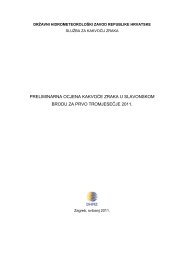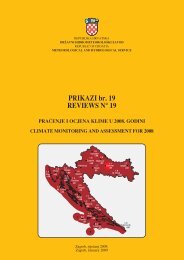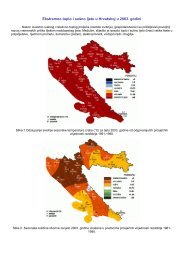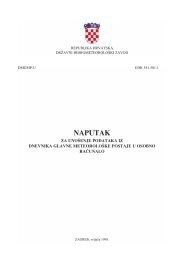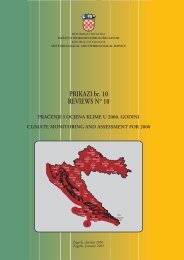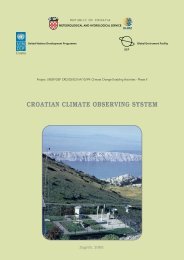Observed climate changes in Croatia Climate change scenario
Observed climate changes in Croatia Climate change scenario
Observed climate changes in Croatia Climate change scenario
Create successful ePaper yourself
Turn your PDF publications into a flip-book with our unique Google optimized e-Paper software.
1. <strong>Observed</strong> <strong>Climate</strong> Changes<br />
Detection of <strong>climate</strong> variations and <strong><strong>change</strong>s</strong> <strong>in</strong> air temperature and precipitation over the<br />
area of <strong>Croatia</strong> s<strong>in</strong>ce the beg<strong>in</strong>n<strong>in</strong>g of the 20 th century has been performed accord<strong>in</strong>g to the<br />
long-term meteorological measurements that started dur<strong>in</strong>g the 19 th century at meteorological<br />
stations <strong>in</strong> different <strong>climate</strong> regions: Osijek (cont<strong>in</strong>ental <strong>climate</strong>), Zagreb-Grič (cont<strong>in</strong>ental <strong>climate</strong><br />
under a mild maritime <strong>in</strong>fluence), Gospić (cont<strong>in</strong>ental <strong>climate</strong> of highland <strong>Croatia</strong> under a strong<br />
maritime <strong>in</strong>fluence), Crikvenica (maritime <strong>climate</strong> of eastern coast of the northern Adriatic) and<br />
Hvar (maritime <strong>climate</strong> of the Dalmatian area).<br />
Decadal trends dur<strong>in</strong>g the 20 th century as well as those till 2008 were compared <strong>in</strong> order<br />
to determ<strong>in</strong>e the differences that appeared due to the <strong><strong>change</strong>s</strong> <strong>in</strong> temperature and precipitation<br />
regimes at the beg<strong>in</strong>n<strong>in</strong>g of the 21 st century.<br />
1.1. Air temperature<br />
Increase of mean annual air temperature, which <strong>in</strong> the 20 th century was between +0.02°C<br />
per 10 years <strong>in</strong> Gospić up to +0.07°C per 10 years <strong>in</strong> Zagreb, cont<strong>in</strong>ued and amplified by the<br />
beg<strong>in</strong>n<strong>in</strong>g of the 21 st century (Table 1-1 and 1-2). In such way, decadal trends were proceed<strong>in</strong>g<br />
until 2004 with<strong>in</strong> the range from 0.04°C up to 0.08°C, and by 2008 between 0.05°C and 0.10°C.<br />
Prevail<strong>in</strong>g positive trend has become particularly expressed with<strong>in</strong> the last 50 years, even more<br />
with<strong>in</strong> the last 25 years (Figure 1-1, Table 1-1). Trends of mean annual air temperature with<strong>in</strong><br />
the 108-year period are statistically significant at all stations except for Osijek, while with<strong>in</strong> the<br />
last 50, i.e. 25 years at all observed stations. The positive temperature trends <strong>in</strong> the cont<strong>in</strong>ental<br />
part of <strong>Croatia</strong> is mostly due to w<strong>in</strong>ter trends (+0.06 °C/10 years <strong>in</strong> Osijek, +0.13 °C/10 years <strong>in</strong><br />
Zagreb and Gospić), while on the Adriatic to summer trends (+0.13 °C/10 years <strong>in</strong> Crikvenica<br />
and +0.07 °C/10 years <strong>in</strong> Hvar). The greatest trends were recorded <strong>in</strong> Zagreb; however, it<br />
should take <strong>in</strong>to account that such <strong>in</strong>crease is partially a result of the urban heat island.<br />
Consequence of the faster atmosphere warm<strong>in</strong>g up dur<strong>in</strong>g the last period of time is a result that<br />
out of ten warmest years s<strong>in</strong>ce the beg<strong>in</strong>n<strong>in</strong>g of the 20 th century 7 of them were recorded <strong>in</strong><br />
Zagreb, 6 <strong>in</strong> Gospić and Crikvenica, 5 <strong>in</strong> Hvar and 4 <strong>in</strong> Osijek (Table 1-3).<br />
2



